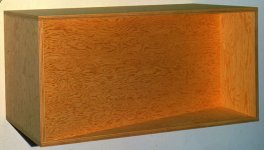ear3
Member
- Joined
- Jul 24, 2014
- Messages
- 4,341
So as a result of the film set/art installation I recently finished up, I've started getting commissions from various people who saw the show. Happy to oblige, of course, since the money is good, though I am going to have to figure out some better work-life-craft balance, as I've been spending waaaaay toooooo much time in the shop....
Anyway, first up is this table modeled after the plywood constructions of the artist Donald Judd, the dimensions of which will be 36"x72"x36":
[attachimg=1]
Fidelity to the original actually works in my favor, as it calls for standard plywood with exposed edges. I'm going to domino and glue the carcasse so that I can at least add a bare minimum of craftsmanship by not having screw holes in the frame, but I'm wondering what people think about that diagonal, which functions as the support (there's no back/side to the table, and thus no option to, say, pocket screw the panel in place without those holes being seen). For this I think I might actually want to use some screws to secure it from the bottom, which will not be visible -- but then on top maybe a few 16ga. nails that I can fill in with putty? My concern is what happens in the middle of the diagonal, and whether any convex bowing on the top board will leave a small gap on the underside with the edge of the diagonal. Worst case I suppose is to add one or two pocket holes along the top of the diagonal that can be filled in with the color appropriate plug.
Also, what, if anything should be done where the mitered edges of the diagonal board meets the sides? I'll be doing everything on-site with track saw, MFT and/or parallel guides, so I will be able to control dimensions to the thousandths of an inch, and am not worried about non-square cuts. But do you think it might be worth adding some 4mm dominos into the beveled edge for purposes of alignment and some gluing surface, or is that unnecessary/overkill?
Thanks for any advice.
Anyway, first up is this table modeled after the plywood constructions of the artist Donald Judd, the dimensions of which will be 36"x72"x36":
[attachimg=1]
Fidelity to the original actually works in my favor, as it calls for standard plywood with exposed edges. I'm going to domino and glue the carcasse so that I can at least add a bare minimum of craftsmanship by not having screw holes in the frame, but I'm wondering what people think about that diagonal, which functions as the support (there's no back/side to the table, and thus no option to, say, pocket screw the panel in place without those holes being seen). For this I think I might actually want to use some screws to secure it from the bottom, which will not be visible -- but then on top maybe a few 16ga. nails that I can fill in with putty? My concern is what happens in the middle of the diagonal, and whether any convex bowing on the top board will leave a small gap on the underside with the edge of the diagonal. Worst case I suppose is to add one or two pocket holes along the top of the diagonal that can be filled in with the color appropriate plug.
Also, what, if anything should be done where the mitered edges of the diagonal board meets the sides? I'll be doing everything on-site with track saw, MFT and/or parallel guides, so I will be able to control dimensions to the thousandths of an inch, and am not worried about non-square cuts. But do you think it might be worth adding some 4mm dominos into the beveled edge for purposes of alignment and some gluing surface, or is that unnecessary/overkill?
Thanks for any advice.

